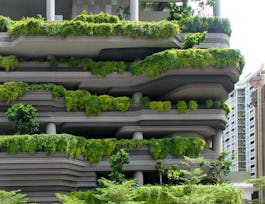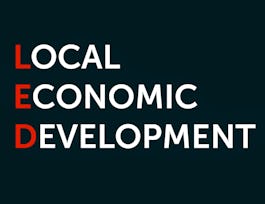The course focuses on contemporary urban planning issues, particularly the Garden City concept, addressing the global trend of integrating green spaces into cities to combat environmental challenges.



Contemporary Garden City Concept from Asia



Instructors: Akito Murayama
Sponsored by Louisiana Workforce Commission
Details to know

Add to your LinkedIn profile
6 assignments
August 2024
See how employees at top companies are mastering in-demand skills


Earn a career certificate
Add this credential to your LinkedIn profile, resume, or CV
Share it on social media and in your performance review

There are 11 modules in this course
Welcome to the Coursera! Dear Students, Welcome to “Contemporary Garden City Concept from Asia”! When you start the course, please take a few minutes to fill out our pre-course survey in this section. This helps us understand who you are so that we can accommodate you in the best way possible. Thank you for your cooperation. We hope to create a great learning community where we can learn from one another. Please post your questions and thoughts and exchange views on the course topics in the Discussion Forum. Your posts will be occasionally monitored by course staff; however, owing to the large number of students and limited resources, we may not be able to answer all questions. We would appreciate your understanding. Thank you for signing up for the course “Contemporary Garden City Concept from Asia.” We hope you enjoy the course! Best Regards, The UTokyo MOOC
What's included
2 readings1 discussion prompt1 plugin
Module 1 will be the introductory part, explaining the critical concepts needed to understand each topic in Module 2 to Module 7.
What's included
1 video
"Agri-residential mixed use neighborhood” is a low-rise residential neighborhood with urban farmlands surrounded by houses often seen in the suburban areas of Tokyo. Urban farmlands are now being re-evaluated as they have multiple benefits economically, socially and environmentally. With reference to the case of Nishitokyo City, land use pattern, land use planning system, and efforts to conserve and create urban farmlands are introduced.
What's included
4 videos1 assignment
This module examines the distinctive landscape of Asia, where agricultural land mixed with residential areas, and explores its formation mechanisms. It challenges traditional urban planning that divides 'urban' and 'rural' areas, and reviews recent studies on the effects of mixed land use. Using Tokyo as a case study, this module examines the characteristics of landscapes that mix agricultural and residential land uses.
What's included
2 videos1 assignment
Contrary to popular belief, cities are not just concrete jungles, but also thriving hubs of agriculture. The global trend of “urban” agriculture has gained significant traction, thanks to its myriad benefits for urban sustainability. This module delves into the fascinating link between urban agriculture and local food systems, a practice that is not only compatible but also thriving in urban-rural mixed areas in Tokyo. The first half of the module provides a comprehensive lecture on the background, concept, and local context, while the second half features insightful interviews with practitioners who are actively supporting local food systems.
What's included
4 videos1 assignment
This module focuses on the historical background and contemporary significance of urban agroforestry systems that integrates agriculture and forestry as one system. It will also address the conservation efforts and challenges by urban farmers to inherite circular systems in the face of urbanization. The importance of recognizing and conserving these systems to address global challenges such as climate change and biodiversity conservation is emphasized.
What's included
4 videos1 assignment
In part 2, the module explores how urban farms in large cities play essential roles as social platforms for people with various backgrounds and needs. The module includes interview clips of two innovative urban farms in Tokyo.
What's included
4 videos1 assignment
While metropolitan development practices and policies, especially those in Tokyo, are mainly discussed in previous modules, smaller regional cities in Japan are also facing various urban problems in particular related to population decline.Therefore, this module shows the expectation of compact city policy and urban agriculture in smaller regional cities for sustainable urban forms both economically and environmentally.
What's included
4 videos1 assignment
Module 8 introduces the Contemporary Garden City Concept from an Asian, particularly Japanese, perspective, highlighting the potential for sustainable urban planning. A comparison of land use in East Rutherford, Argenteuil, and Nerima not only illustrates differences in urban-rural integration but also underscores the global relevance of this issue. In Module 8, the lecture is conducted as a panel discussion with experts from the UK, Italy, and Germany to explore international perspectives on Japanese urban agriculture and its implications for the Contemporary Garden City Concept. Three questions are posed to the panelists regarding similarities, potential learning opportunities, and the role of urban agriculture in a changing world.
What's included
5 videos
What's included
1 reading
What's included
1 plugin
Instructors



Offered by
Why people choose Coursera for their career




Recommended if you're interested in Social Sciences

Johns Hopkins University

Erasmus University Rotterdam

Banco Interamericano de Desarrollo

Technical University of Denmark (DTU)

Open new doors with Coursera Plus
Unlimited access to 10,000+ world-class courses, hands-on projects, and job-ready certificate programs - all included in your subscription
Advance your career with an online degree
Earn a degree from world-class universities - 100% online
Join over 3,400 global companies that choose Coursera for Business
Upskill your employees to excel in the digital economy








